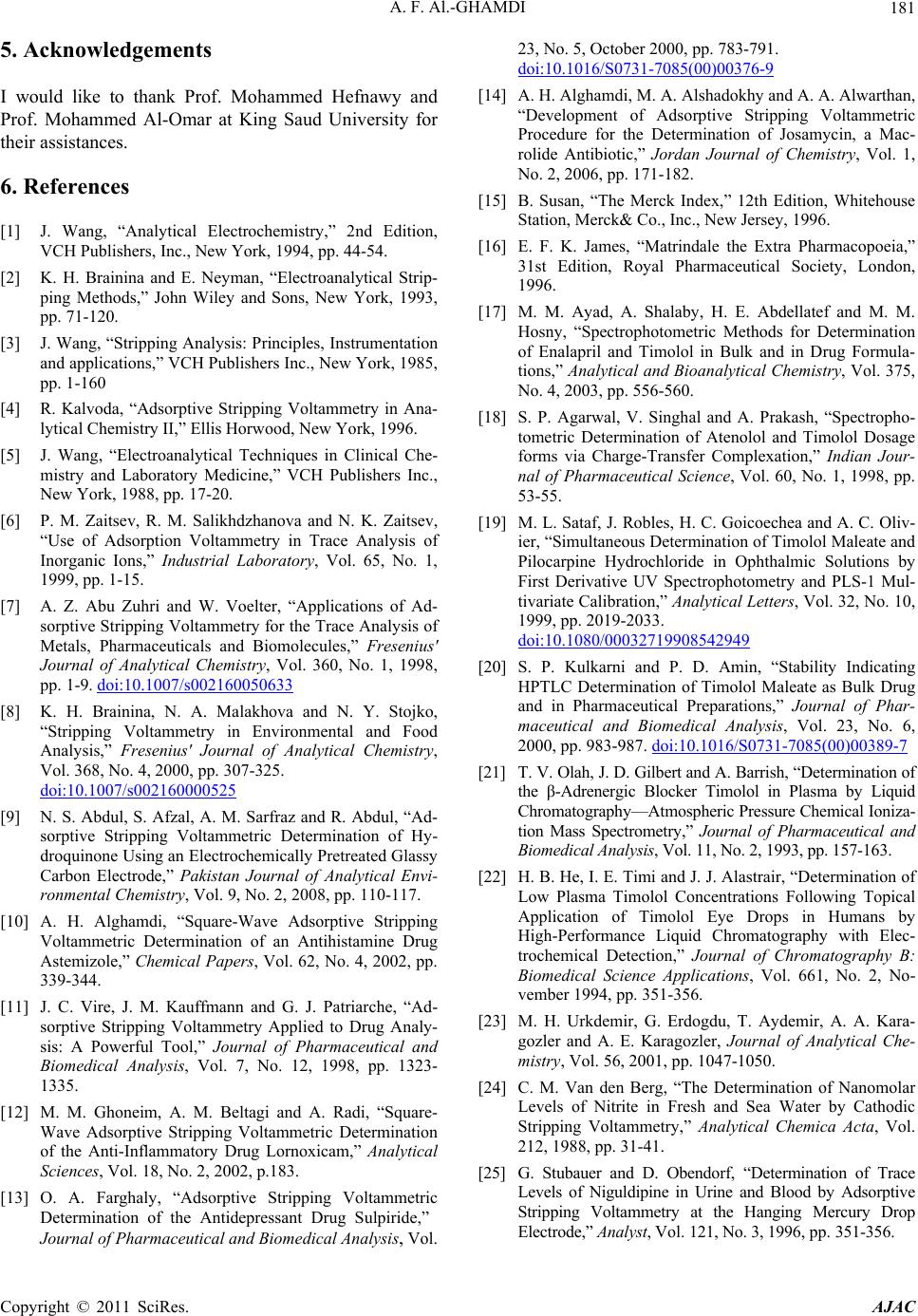
A. F. Al.-GHAMDI
Copyright © 2011 SciRes. AJAC
181
5. Acknowledgements
I would like to thank Prof. Mohammed Hefnawy and
Prof. Mohammed Al-Omar at King Saud University for
their assistances.
6. References
[1] J. Wang, “Analytical Electrochemistry,” 2nd Edition,
VCH Publishers, Inc., New York, 1994, pp. 44-54.
[2] K. H. Brainina and E. Neyman, “Electroanalytical Strip-
ping Methods,” John Wiley and Sons, New York, 1993,
pp. 71-120.
[3] J. Wang, “Stripping Analysis: Principles, Instrumentation
and applications,” VCH Publishers Inc., New York, 1985,
pp. 1-160
[4] R. Kalvoda, “Adsorptive Stripping Voltammetry in Ana-
lytical Chemistry II,” Ellis Horwood, New York, 1996.
[5] J. Wang, “Electroanalytical Techniques in Clinical Che-
mistry and Laboratory Medicine,” VCH Publishers Inc.,
New York, 1988, pp. 17-20.
[6] P. M. Zaitsev, R. M. Salikhdzhanova and N. K. Zaitsev,
“Use of Adsorption Voltammetry in Trace Analysis of
Inorganic Ions,” Industrial Laboratory, Vol. 65, No. 1,
1999, pp. 1-15.
[7] A. Z. Abu Zuhri and W. Voelter, “Applications of Ad-
sorptive Stripping Voltammetry for the Trace Analysis of
Metals, Pharmaceuticals and Biomolecules,” Fresenius'
Journal of Analytical Chemistry, Vol. 360, No. 1, 1998,
pp. 1-9. doi:10.1007/s002160050633
[8] K. H. Brainina, N. A. Malakhova and N. Y. Stojko,
“Stripping Voltammetry in Environmental and Food
Analysis,” Fresenius' Journal of Analytical Chemistry,
Vol. 368, No. 4, 2000, pp. 307-325.
doi:10.1007/s002160000525
[9] N. S. Abdul, S. Afzal, A. M. Sarfraz and R. Abdul, “Ad-
sorptive Stripping Voltammetric Determination of Hy-
droquinone Using an Electrochemically Pretreated Glassy
Carbon Electrode,” Pakistan Journal of Analytical Envi-
ronmental Chemistry, Vol. 9, No. 2, 2008, pp. 110-117.
[10] A. H. Alghamdi, “Square-Wave Adsorptive Stripping
Voltammetric Determination of an Antihistamine Drug
Astemizole,” Chemical Papers, Vol. 62, No. 4, 2002, pp.
339-344.
[11] J. C. Vire, J. M. Kauffmann and G. J. Patriarche, “Ad-
sorptive Stripping Voltammetry Applied to Drug Analy-
sis: A Powerful Tool,” Journal of Pharmaceutical and
Biomedical Analysis, Vol. 7, No. 12, 1998, pp. 1323-
1335.
[12] M. M. Ghoneim, A. M. Beltagi and A. Radi, “Square-
Wave Adsorptive Stripping Voltammetric Determination
of the Anti-Inflammatory Drug Lornoxicam,” Analytical
Sciences, Vol. 18, No. 2, 2002, p.183.
[13] O. A. Farghaly, “Adsorptive Stripping Voltammetric
Determination of the Antidepressant Drug Sulpiride,”
Journal of Pharmaceutical and Biomedical Analysis, Vol.
23, No. 5, October 2000, pp. 783-791.
doi:10.1016/S0731-7085(00)00376-9
[14] A. H. Alghamdi, M. A. Alshadokhy and A. A. Alwarthan,
“Development of Adsorptive Stripping Voltammetric
Procedure for the Determination of Josamycin, a Mac-
rolide Antibiotic,” Jordan Journal of Chemistry, Vol. 1,
No. 2, 2006, pp. 171-182.
[15] B. Susan, “The Merck Index,” 12th Edition, Whitehouse
Station, Merck& Co., Inc., New Jersey, 1996.
[16] E. F. K. James, “Matrindale the Extra Pharmacopoeia,”
31st Edition, Royal Pharmaceutical Society, London,
1996.
[17] M. M. Ayad, A. Shalaby, H. E. Abdellatef and M. M.
Hosny, “Spectrophotometric Methods for Determination
of Enalapril and Timolol in Bulk and in Drug Formula-
tions,” Analytical and Bioanalytical Chemistry, Vol. 375,
No. 4, 2003, pp. 556-560.
[18] S. P. Agarwal, V. Singhal and A. Prakash, “Spectropho-
tometric Determination of Atenolol and Timolol Dosage
forms via Charge-Transfer Complexation,” Indian Jour-
nal of Pharmaceutical Science, Vol. 60, No. 1, 1998, pp.
53-55.
[19] M. L. Sataf, J. Robles, H. C. Goicoechea and A. C. Oliv-
ier, “Simultaneous Determination of Timolol Maleate and
Pilocarpine Hydrochloride in Ophthalmic Solutions by
First Derivative UV Spectrophotometry and PLS-1 Mul-
tivariate Calibration,” Analytical Letters, Vol. 32, No. 10,
1999, pp. 2019-2033.
doi:10.1080/00032719908542949
[20] S. P. Kulkarni and P. D. Amin, “Stability Indicating
HPTLC Determination of Timolol Maleate as Bulk Drug
and in Pharmaceutical Preparations,” Journal of Phar-
maceutical and Biomedical Analysis, Vol. 23, No. 6,
2000, pp. 983-987. doi:10.1016/S0731-7085(00)00389-7
[21] T. V. Olah, J. D. Gilbert and A. Barrish, “Determination of
the β-Adrenergic Blocker Timolol in Plasma by Liquid
Chromatography—Atmospheric Pressure Chemical Ioniza-
tion Mass Spectrometry,” Journal of Pharmaceutical and
Biomedical Analysis, Vol. 11, No. 2, 1993, pp. 157-163.
[22] H. B. He, I. E. Timi and J. J. Alastrair, “Determination of
Low Plasma Timolol Concentrations Following Topical
Application of Timolol Eye Drops in Humans by
High-Performance Liquid Chromatography with Elec-
trochemical Detection,” Journal of Chromatography B:
Biomedical Science Applications, Vol. 661, No. 2, No-
vember 1994, pp. 351-356.
[23] M. H. Urkdemir, G. Erdogdu, T. Aydemir, A. A. Kara-
gozler and A. E. Karagozler, Journal of Analytical Che-
mistry, Vol. 56, 2001, pp. 1047-1050.
[24] C. M. Van den Berg, “The Determination of Nanomolar
Levels of Nitrite in Fresh and Sea Water by Cathodic
Stripping Voltammetry,” Analytical Chemica Acta, Vol.
212, 1988, pp. 31-41.
[25] G. Stubauer and D. Obendorf, “Determination of Trace
Levels of Niguldipine in Urine and Blood by Adsorptive
Stripping Voltammetry at the Hanging Mercury Drop
Electrode,” Analyst, Vol. 121, No. 3, 1996, pp. 351-356.